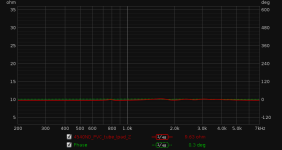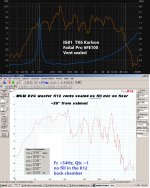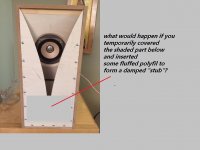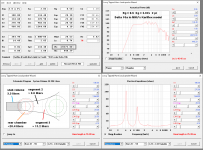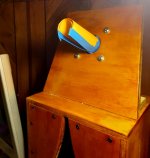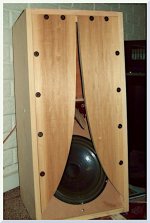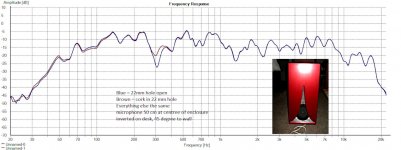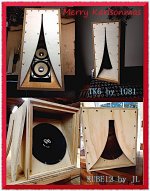Notch - I suppose it depends whether it still shows up after padding and rolling-off.
APT50 with the paper/fiberglass K-Tube.
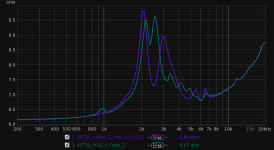
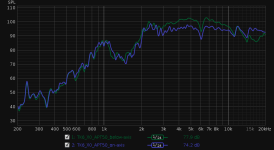
Not as good a response as the 4540ND, but we can still the the same on and below axis behavior. That 6kHz notch also shows up with the small Eminence horn.
I'm making a second paper/fiberglass/glue K-tube, where I'll try to get the slot much closer to the driver's exit. It will also be of correct diameter and much closer to a perfect circle.
APT50 with the paper/fiberglass K-Tube.


Not as good a response as the 4540ND, but we can still the the same on and below axis behavior. That 6kHz notch also shows up with the small Eminence horn.
I'm making a second paper/fiberglass/glue K-tube, where I'll try to get the slot much closer to the driver's exit. It will also be of correct diameter and much closer to a perfect circle.
Last edited:
my ancient APT50 exhibited dips @~5.8KHz and an octave higher on my straight schedule 40 pipe version of "The Tube". (TPC's product had a 2 degree sidewall downwards taper)
Does your APT50 have the plastic APT3 adapter ? -or is it metal threaded ? IIRC the late Bob Crites stopped production on a K-horn tweeter replacement when one version of APT50 had too much HF rolloff.
Can you locate the front chamber center resonance with a sine wave generator and "by ear"?
Does your APT50 have the plastic APT3 adapter ? -or is it metal threaded ? IIRC the late Bob Crites stopped production on a K-horn tweeter replacement when one version of APT50 had too much HF rolloff.
Can you locate the front chamber center resonance with a sine wave generator and "by ear"?
Attachments
Last edited:
The old-school RJ (not Supravox-style) is already a bandpass like a Karlson, save for a much smaller front chamber, so I suppose it might turn out to be a BP8. I don't know if this would be worthwhile.
Appreciate the input. I'm kind of with you on the value. Wasn't thinking R-J w/ the real lemon or slot etc. as extra front load, more toward peripheral Helmholtzey slot with some viscous damping. I think Fred was close. Just something to muddle the balance of compliances and inertances in there, but with more stiffness on the back side of the cone from the little compliance. It would tune higher and be kind of worthless, but it could (?) be smoother. As with all K-stuff, I guess that's my experiment to make, but it'd be pretty far down the list. With a new day's eyes, at LF, it's just a VB in series with another inertance, but obviously not in the same realm as the k'ator stuff which gets extension. I gave upon K-stuff because I couldn't figure out how to de-tunnelize the sound and un-W-ize the FR. That stuff was a long time ago, but you guys and Moray always get me thinking. The thing I like most is that it all seems like one of the last spots that's not computerized and optimized to the nines--it's still the same sort of liberating wild-frontier that used to be fun. Thanks for posting all this stuff.
my ancient APT50 exhibited dips @~5.8KHz and an octave higher on my straight schedule 40 pipe version of "The Tube". (TPC's product had a 2 degree sidewall downwards taper)
Does your APT50 have the plastic APT3 adapter ? -or is it metal threaded ? IIRC the late Bob Crites stopped production on a K-horn tweeter replacement when one version of APT50 had too much HF rolloff.
Can you locate the front chamber center resonance with a sine wave generator and "by ear"?
IMO, the 2 degree taper was most likely just for easing removal from the production mold. The slot's expansion likely swamps any effect it might have on an otherwise unslotted tube.
I have the modern metal-threaded APT50.
I never went about it Hz by Hz by ear, but it would likely be ~175Hz on my box, if this is what you mean.
Appreciate the input. I'm kind of with you on the value. Wasn't thinking R-J w/ the real lemon or slot etc. as extra front load, more toward peripheral Helmholtzey slot with some viscous damping.
............
I gave upon K-stuff because I couldn't figure out how to de-tunnelize the sound and un-W-ize the FR. That stuff was a long time ago, but you guys and Moray always get me thinking. The thing I like most is that it all seems like one of the last spots that's not computerized and optimized to the nines--it's still the same sort of liberating wild-frontier that used to be fun. Thanks for posting all this stuff.
The RJ you describe is then more akin to the Supravox implementation, with no cone restriction at the front. The lemon RJ has the baffle inside the box, while Supravox's is outside. I might build a little Supravox-RJ for either TB W4-1320SIF or Fostex FF125K, from leftover BB-ply I have.
I sort of gave up on Karlson some years back, more because it doesn't work for me as a daily driver, but it still did enough right that I like to tinker, especially the K-Tube, it's more the LF units that can be problematic, but hey, here I am building one again!
my 41.5" tallK18 could be my daily speaker but requires skill to make the curved reflector plus would look better at 36" tall.
An "HAK10" would be something I could use -maybe 26" tall external-?
It's great IG81 is stepping into 😀-uh- unknown and poorly understood territory ....
An "HAK10" would be something I could use -maybe 26" tall external-?
It's great IG81 is stepping into 😀-uh- unknown and poorly understood territory ....
-when I mucked with a 28 inch tall HAK8 ("high aspect") , it seemed it might measure better at 24" external height (?) sound quality was pretty good -
that's a sax track from Alan Parson's "Sound Check" - good for evaluation as has no "adornments"
There's plenty to adjust with a K including inner port location, port aspect, port area.
If an an XKi with a long shelf port is made then a "V" notch in the shelf may reduce cancellation effects (see Nexos' patents), cavity shape matters, aperture flare and initial gap matter, - lowpass-shelf gap if employed has effects, front shelf protuberance has effects,reflector shape and if curved matter. Damping placement matters. A lot of this is heard in the near field but will not show with mic measurements.
High Aspect Karlson coupler with Tangband W8-1772 - Saxophone - YouTube
that's a sax track from Alan Parson's "Sound Check" - good for evaluation as has no "adornments"
There's plenty to adjust with a K including inner port location, port aspect, port area.
If an an XKi with a long shelf port is made then a "V" notch in the shelf may reduce cancellation effects (see Nexos' patents), cavity shape matters, aperture flare and initial gap matter, - lowpass-shelf gap if employed has effects, front shelf protuberance has effects,reflector shape and if curved matter. Damping placement matters. A lot of this is heard in the near field but will not show with mic measurements.
High Aspect Karlson coupler with Tangband W8-1772 - Saxophone - YouTube
I really like horns in general and still have- 3K-horn, 2-Peavey FH1, one custom RCA-Fan FLH, 2-EV Sentry FLH, 1 scaled University Classic. An Acoustic Control 115BK, K12, and old K15, can outpoint some of these horns -particularly with bowed bass viola.
FWIW I view K12/X15/115BK as viable substitute for some midbass horn, assuming adequate power.
FWIW I view K12/X15/115BK as viable substitute for some midbass horn, assuming adequate power.
-wonder if there's a way without physically building or Akabak3 to determine a front chamber which inherently plays smoother than others?
A stub can be added to a front chamber and that adds volume. and can mull a peak while reducing reflections.
There's a MCM DVC 12" speaker which meets spec that will work in a stock K12
(sealed)
It might be interesting to make a test box where the K-baffle and reflector can be adjusted during measurements
A stub can be added to a front chamber and that adds volume. and can mull a peak while reducing reflections.
There's a MCM DVC 12" speaker which meets spec that will work in a stock K12
(sealed)
It might be interesting to make a test box where the K-baffle and reflector can be adjusted during measurements
Attachments
I have a bit of updating to do. I fudged a passable crossover between the TK6-6FE100 and 4540ND-KTube, if only to make the system listenable with some HF content. The 6FE100 isn't doing very well in there, which I somewhat expected. Factory data looks OK, but mine have Qt~0.85, so there you go. The low frequencies are boomy and muddled, possibly worse than when I stuck a high-compliance Foster 12" woofer in my K12. Karlsons have a varying degree of colourations and I'm not yet familiar yet with the sound of this one.
I had a bit of a backup plan and implemented it, even if still not ideal, as a sort of (in)sanity check. Fostex FF125k. 4.5" is about the lower limit of what I would put in a 6" koupler, but it does have a strong motor and a rising response usually known to do well. My two units differ in measured T/S parameters and I chose the higher compliance one, Vas~9.5 liters, Fs~70Hz and Qt~0.34. I cut a sub-baffle and glued a sheet of craft foam to be both driver and baffle gasket.
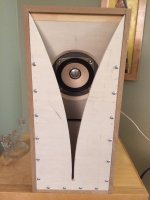
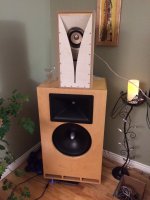
Not needing to futz about with caps'n'coils, I quickly got some music into it. It was quickly apparent that the match was far better than with the 6FE100. The fullrange coherence also put to shame my quick and dirty crossover. It doesn't play very low and the cutoff is steep, but can make some noise above 80Hz despite a 0.15mm Xmax driver. There are resonances somewhere in the upper bass, as measured earlier, these are more kabinet related than driver or alignment, I'll see if I can alleviate these any. I should probably design a "mellowizer" network to tame the high-end of the FF125K, it probably doesn't get choked down enough by wing intercept.
As pictured above, getting it up on top of my TD15M boxes produced the best results in my room. I think I found the upside-down or sideways position to sound better than upright as well. Picked acoustic guitar sounded pretty good, and most vocals fair enough or better. Wind instruments felt well reproduced. Some of the idiosynkracies can be euphonic on certain material. I forgot where I read this lately, but it was mentioned of VOTT systems sounding like live music, which this little K sort of can, though on a smaller scale. Speaking of scale, it is somewhat lacking on the heavier movements from Dvorak's New World Symphony. I recall my K12 doing well on this, the SK8 at least decent. A competent 6" driver would of course help.
I was eyeing 5" and 6" SB Acoustic and Dayton mid-woofers that have good specs for this TK6 and are cheaper than a steak dinner. I'll see if I can tweak it some more to my liking with the FF125K for now.
I had a bit of a backup plan and implemented it, even if still not ideal, as a sort of (in)sanity check. Fostex FF125k. 4.5" is about the lower limit of what I would put in a 6" koupler, but it does have a strong motor and a rising response usually known to do well. My two units differ in measured T/S parameters and I chose the higher compliance one, Vas~9.5 liters, Fs~70Hz and Qt~0.34. I cut a sub-baffle and glued a sheet of craft foam to be both driver and baffle gasket.


Not needing to futz about with caps'n'coils, I quickly got some music into it. It was quickly apparent that the match was far better than with the 6FE100. The fullrange coherence also put to shame my quick and dirty crossover. It doesn't play very low and the cutoff is steep, but can make some noise above 80Hz despite a 0.15mm Xmax driver. There are resonances somewhere in the upper bass, as measured earlier, these are more kabinet related than driver or alignment, I'll see if I can alleviate these any. I should probably design a "mellowizer" network to tame the high-end of the FF125K, it probably doesn't get choked down enough by wing intercept.
As pictured above, getting it up on top of my TD15M boxes produced the best results in my room. I think I found the upside-down or sideways position to sound better than upright as well. Picked acoustic guitar sounded pretty good, and most vocals fair enough or better. Wind instruments felt well reproduced. Some of the idiosynkracies can be euphonic on certain material. I forgot where I read this lately, but it was mentioned of VOTT systems sounding like live music, which this little K sort of can, though on a smaller scale. Speaking of scale, it is somewhat lacking on the heavier movements from Dvorak's New World Symphony. I recall my K12 doing well on this, the SK8 at least decent. A competent 6" driver would of course help.
I was eyeing 5" and 6" SB Acoustic and Dayton mid-woofers that have good specs for this TK6 and are cheaper than a steak dinner. I'll see if I can tweak it some more to my liking with the FF125K for now.
(FWIW, regarding The Tube's 2 degree downwards taper, Walter Alan Zintz of Transylvania Power Company felt that related to Karlson's first Acoustic Transducers patent with the tapering chamber than the molding process)
TK6 looks very nice, inverted with the little Fostex fullrange. FE206en was loads of fun in a K12.I tried a Dayton PA310 in K12 and sounded like it was submerged 50 ft underwater-while Kappa12A was very clear. A de-whizzered FE164 was very good in the karlsonator 6 prototype.
TK6 looks very nice, inverted with the little Fostex fullrange. FE206en was loads of fun in a K12.I tried a Dayton PA310 in K12 and sounded like it was submerged 50 ft underwater-while Kappa12A was very clear. A de-whizzered FE164 was very good in the karlsonator 6 prototype.
Here are a couple of measurements on TK6 - FF125K.
TK6 vs 8L reflex (my avatar), at 25cm, relative SPL is correct:
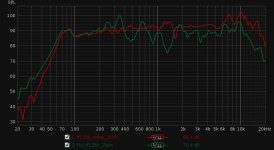
I'm a bit surprised the TK6 isn't a bit more sensitive in the BP6 region, perhaps the tuning is a bit low for FF125K, but tuning higher might increase the ~80Hz peaking, still, easy enough to try.
FF125K vs 6EF100 both in TK6, at 1m, SPL is not relative as taken in different sessions and amplifier, I normalized for 1kHz:
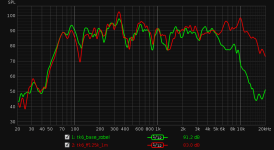
The above graph is surprisingly not telling of the different LF subjective performance between both drivers. If anything, I'd favour 6FE100 based on it.
Trying to block the upper part of the K-slot sounds easy enough, I'll add it to my list of things to try.
There is also a 6" SB coaxial that looks well-spec'd for this TK6, it's not too pricey either. I do like fullrange units in Karlson though. FF165WK or FE166NV might be good, but are somewhat above the econo-budget for this project.
TK6 vs 8L reflex (my avatar), at 25cm, relative SPL is correct:

I'm a bit surprised the TK6 isn't a bit more sensitive in the BP6 region, perhaps the tuning is a bit low for FF125K, but tuning higher might increase the ~80Hz peaking, still, easy enough to try.
FF125K vs 6EF100 both in TK6, at 1m, SPL is not relative as taken in different sessions and amplifier, I normalized for 1kHz:

The above graph is surprisingly not telling of the different LF subjective performance between both drivers. If anything, I'd favour 6FE100 based on it.
Trying to block the upper part of the K-slot sounds easy enough, I'll add it to my list of things to try.
There is also a 6" SB coaxial that looks well-spec'd for this TK6, it's not too pricey either. I do like fullrange units in Karlson though. FF165WK or FE166NV might be good, but are somewhat above the econo-budget for this project.
Hi IG81
attached is what I could find of Ken Lehman's 8 inch K-coupler experiment witha polycone, low fs Eclipse woofer.
unfortunate, I've not been able to find its response without the smoothing stub but suffice to say it looked "rough"
With stub added frequency and impulse response improved -"echoes" disapeared or lessened.
MMJ worked out a hornresp fudge for K with stub which may be helpful.
attached is what I could find of Ken Lehman's 8 inch K-coupler experiment witha polycone, low fs Eclipse woofer.
unfortunate, I've not been able to find its response without the smoothing stub but suffice to say it looked "rough"
With stub added frequency and impulse response improved -"echoes" disapeared or lessened.
MMJ worked out a hornresp fudge for K with stub which may be helpful.
Attachments
If you get time and easy way to mount, I'd like to see your opinions on paper K-tubes so far (including blunt nose-- I snipped this awful looking thing - sounds better than my metal tube (at least up close andoff axis) - you might come up with something good)
Attachments
Last edited:
I've done a bit of re-configuring to the basic enclosure with FF125K. 15L is about twice what this driver wants, even on the high side, so I doubled-up, which will make for a saner LF alignment. I was also inspired by a few recent Karlsonator dual-driver builds. I now had the Sd of roughly a 6" driver. I may yet buy one if I can make the box behave well enough for me, but it might have to be a midbass, as there are no or few suitable fullrange and coax that won't break the econo-budget for this project.

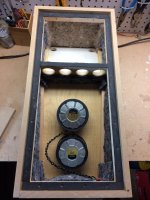
I had to remove the previous slant baffle, which was glued, but a good whack with a hammer took care of it without removing much MDF from the sides, as I dreaded. This new baffle is screwed on and removable, The venting was a central slot, which I now blocked with a new rear holey-shelf, which braces the back panel as well. It protrudes about 0.25" in front. Venting is now done at the very top of the reflector. I haven`t measured yet, but I think I might have to enlarge or add holes to keep the same Fb, or even go a bit higher, ~75-80Hz, as I think it would work better. I'm hoping this will somewhat alleviate a few FR warts in the upper bass and/or lower midrange.
I also replaced the poor and minimal surface damping material I had in there with 0.5" upholstery felt. Not pictured is the back panel which is also mostly lined with the same.
I also braced the wings with some 1/4 hex bolts and tee-nuts. I had previously done so successfully on my Karlsonettes, the difference was that the threaded rods came in from the central panel and a filed point poked into the wings, whereas I've here installed the tee-nuts in the wings, à la Acoustic Control BK-15, save for the fact that I push on the wings from the inside instead of pulling them inwards. My hex bolts merely push on the shelf board, I may yet revise this, but it should do for now, the wing assembly is much stiffer now.
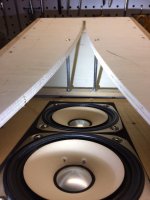
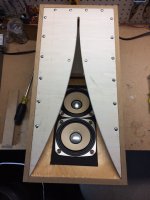
I will take a few measurement and listen to them when I get some time, as I finished the assembly late last night.
As for K-Tubes, I've completed one I'm happy with on a workmanship level and will likely first test it on top of dual 6FE100 in a sealed enclosure, so as to avoid too much midrange kolouration from the TK6 for initial subjective impressions.


I had to remove the previous slant baffle, which was glued, but a good whack with a hammer took care of it without removing much MDF from the sides, as I dreaded. This new baffle is screwed on and removable, The venting was a central slot, which I now blocked with a new rear holey-shelf, which braces the back panel as well. It protrudes about 0.25" in front. Venting is now done at the very top of the reflector. I haven`t measured yet, but I think I might have to enlarge or add holes to keep the same Fb, or even go a bit higher, ~75-80Hz, as I think it would work better. I'm hoping this will somewhat alleviate a few FR warts in the upper bass and/or lower midrange.
I also replaced the poor and minimal surface damping material I had in there with 0.5" upholstery felt. Not pictured is the back panel which is also mostly lined with the same.
I also braced the wings with some 1/4 hex bolts and tee-nuts. I had previously done so successfully on my Karlsonettes, the difference was that the threaded rods came in from the central panel and a filed point poked into the wings, whereas I've here installed the tee-nuts in the wings, à la Acoustic Control BK-15, save for the fact that I push on the wings from the inside instead of pulling them inwards. My hex bolts merely push on the shelf board, I may yet revise this, but it should do for now, the wing assembly is much stiffer now.


I will take a few measurement and listen to them when I get some time, as I finished the assembly late last night.
As for K-Tubes, I've completed one I'm happy with on a workmanship level and will likely first test it on top of dual 6FE100 in a sealed enclosure, so as to avoid too much midrange kolouration from the TK6 for initial subjective impressions.
Last edited:
Here are a couple of measurements I took on the new configuration. These are all taken with the microphone at the K-slot's plane, roughly 8" down from its apex. I find it to show well enough what goes on in the lower range.
Single-driver VS dual driver, clearly showing the improved bass alignment (SPL not relative as taken in different sessions):
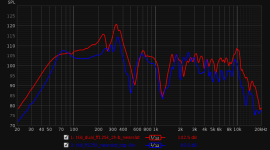
I sealed the two vent holes with duct-seal to check the sealed response versus vented:

The tuning frequency achieved by two 1" holes was about 58Hz, roughly what I expected. I drilled two more 1" holes, also at the top, which raised tuning to 67Hz. Here are the comparative responses:
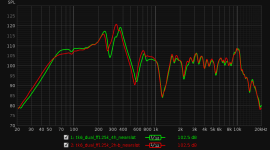
The mid-upper 200Hz range dip is the rear and front wavefront 180deg cancellation, which checks out with distance to vent and the fact that it is not present on the sealed response.
The ~300Hz peaking is most likely the front cavity helmholtz resonance. It is fairly prominent here. I have lost all but one of my K12 and SK8 measurements. Perhaps my K12 exhibited some peaking, but my memory of SK8 and the one trace I have left show it not to have such a pronounced peak.
The mid-500Hz suckout, I have yet to figure out. It's also present on the sealed configuration. Going from 1, 2, 3 and 4 open vent holes slightly shifts its frequency and the depth changes, but nothing major.
The 1200Hz suckout is always there and somewhat more immutable.
I have a few ideas to track down these issues and perhaps then alleviate them a bit.
freddi - your wingless near-port plots from post #18 show some peaking around 250Hz, likely a standing wave, which is something I need to measure on the TK6.
Single-driver VS dual driver, clearly showing the improved bass alignment (SPL not relative as taken in different sessions):

I sealed the two vent holes with duct-seal to check the sealed response versus vented:

The tuning frequency achieved by two 1" holes was about 58Hz, roughly what I expected. I drilled two more 1" holes, also at the top, which raised tuning to 67Hz. Here are the comparative responses:

The mid-upper 200Hz range dip is the rear and front wavefront 180deg cancellation, which checks out with distance to vent and the fact that it is not present on the sealed response.
The ~300Hz peaking is most likely the front cavity helmholtz resonance. It is fairly prominent here. I have lost all but one of my K12 and SK8 measurements. Perhaps my K12 exhibited some peaking, but my memory of SK8 and the one trace I have left show it not to have such a pronounced peak.
The mid-500Hz suckout, I have yet to figure out. It's also present on the sealed configuration. Going from 1, 2, 3 and 4 open vent holes slightly shifts its frequency and the depth changes, but nothing major.
The 1200Hz suckout is always there and somewhat more immutable.
I have a few ideas to track down these issues and perhaps then alleviate them a bit.
freddi - your wingless near-port plots from post #18 show some peaking around 250Hz, likely a standing wave, which is something I need to measure on the TK6.
I'd love to see data on one of Carl's HAK8 which also employed vent at the top of the reflector-Perhaps the SK6.5 based (~directly scaled) on it tells the general response story-?
Attachments
- Home
- Loudspeakers
- Multi-Way
- Karlson "TK6" & K-Tube

